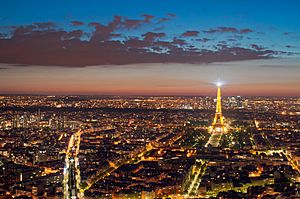Metropolitan area facts for kids
A metropolitan area is a big city and all the smaller towns and suburbs around it that are closely connected. Think of it like a city's huge neighborhood! The word "metropolitan" comes from two old Greek language words: "meter," meaning "mother," and "polis," meaning "city." So, it's like the "mother city" and all its connected areas.
A metropolitan area can be much, much bigger than just the main inner city. The suburbs might have started as small towns or villages, but as the main city grew, they became part of this larger connected area. For example, the biggest metropolitan area in the world is Tokyo in Japan. While about 8.5 million people live in Tokyo's main city, an amazing 36.5 million people live in the entire Tokyo metropolitan area!
A metropolitan area is a very large urban area. When you look at it, the main city often blends right into the surrounding buildings and lights. The whole area, full of buildings and people, is what we call the metropolitan area. The main city might be in the middle, or sometimes it's off to one side. Some really big urban areas can even have more than one main city within them!
Contents
What Makes Up a Metropolitan Area?
A metropolitan area includes the main city and all the places around it where people live, work, and travel every day. These areas are connected by roads, public transport, and shared services like water and electricity.
The Main City
This is the central part, often called the "core city" or "central city." It's usually the oldest and biggest part, with lots of businesses, government buildings, and cultural places like museums and theaters.
Suburbs and Towns
These are the areas surrounding the main city. Many people who work in the main city live in the suburbs because they might find more space or different kinds of homes there. These towns and villages become part of the metropolitan area as they grow closer to the main city. People often travel (or "commute") from the suburbs into the main city for work or school.
Why Are Metropolitan Areas Important?
Metropolitan areas are super important because they are centers for many things.
Economy and Jobs
They are often the economic engines of a country. Many businesses, factories, and offices are located here, creating lots of jobs. This is why so many people move to metropolitan areas.
Culture and Education
These areas are also hubs for culture, education, and entertainment. You'll find universities, hospitals, sports stadiums, and a wide variety of restaurants and shops. They offer many opportunities for learning and fun.
Transportation Hubs
Metropolitan areas usually have big airports, train stations, and bus systems. These transport links help people move around easily within the area and connect to other parts of the country or the world.
Biggest Metropolitan Areas in the World
Some of the largest metropolitan areas by population include:
- Tokyo, Japan
- Delhi, India
- Shanghai, China
- São Paulo, Brazil
- Mexico City, Mexico
- New York City, USA
These places are home to tens of millions of people and are constantly growing and changing.
Images for kids
-
Satellite imagery showing the New York metropolitan area at night. Long Island extends to the east of the central core of Manhattan.
-
Greater São Paulo at night seen from the International Space Station
See also
 In Spanish: Área metropolitana para niños
In Spanish: Área metropolitana para niños




